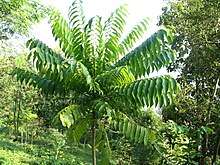Dracontomelon dao
Dracontomelon dao, the New Guinea walnut, Pacific walnut, or Paldao, is a tropical canopy tree distinguished mostly by its height (reaching up to about 45 metres or 148 feet), for its greyish-brown trunk which is branchless up to about 20 m (66 ft), and for its narrow buttresses which can reach up its trunk up to 6 m (20 ft) high.[2] The species name is taken from the tree's name in Filipino.
| Dracontomelon dao | |
|---|---|
 | |
| Young crown | |
| Scientific classification | |
| Kingdom: | Plantae |
| Clade: | Tracheophytes |
| Clade: | Angiosperms |
| Clade: | Eudicots |
| Clade: | Rosids |
| Order: | Sapindales |
| Family: | Anacardiaceae |
| Subfamily: | Spondiadoideae |
| Genus: | Dracontomelon |
| Species: | D. dao |
| Binomial name | |
| Dracontomelon dao | |
| Synonyms | |
|
List
| |
Distribution
D. dao is found in the tropical forests of: peninsular Malaysia (Kedah, Kelantan, Trengganu, Penang Isl., Perak, Pahan, Selangor, Negeri Sembilan), Borneo, Sumatra, Philippines (Luzon, Mindoro, Tablas, Negros, Leyte, Samar, Basilan, Mindanao, Palawan), Lesser Sunda Isl., Java, Sulawesi, Moluccas, New Guinea, Solomons, Andamans (South Andamans), Nicobars (Car Nicobar Island), E-India, Myanmar [Burma] (Kachin, Rakhine, Sagaing, Taninthayi, Mandalay, Yangon), Cambodia, Laos, Thailand and Vietnam.[2]
In popular culture
Use in decoration
The seed surface typically displays an intricate pattern with an approximate five-fold symmetry, and its five rhombic protrusions are reminiscent of primitive Buddha images. It is revered and called "Five Buddhas" in the North-East of Thailand and in Laos.
Namesake localities
The municipality of Dao, Capiz and the Barangay (village) of Dau in Mabalacat, Pampanga are named after the dao tree.
UPLB's leaning Dao
A specific specimen of Dracontomelon dao has become an icon for students and a tourist attraction of sorts for the University of the Philippines Los Baños.[3][4][5]
The tree inspired National Artist Leandro Locsin's design for the university's Student Union building, and for the buildings that now house UPLB's College of Agriculture and College of Development Communication - all three Locsin-designed buildings bearing a motif of repeating dao-like buttressed columns. The tree itself stood on the banks of Molawin Creek, on the site where the Student Union building was commissioned to be put up, so Locsin made the tree an element part of the building's layout, standing at the passenger drop-off point in front of the main entrance.[4]
Some time before 2005, the dao gradually began to lean "20 degrees to the side with respect to its vertical position due to its heavy crown and weakened root system", leading then-Chancellor Wilfredo P. David to order that it be cut down in 2005.[4][5] With testimony from some of UPLB's plant pathologists and urban forestry experts, and support from the Philippines' National Commission on Culture and the Arts and Department of Environment and Natural Resources, protesters managed to prevent the tree from being cut until David's term ended, after which the next chancellor, Luis Rey I. Velasco, decided not to cut it, and instead declared it one of the University's twelve "Centennial Heritage Trees."[3][4][5] When Typhoon Milenyo battered Los Baños and caused numerous trees in UPLB to fall down, the leaning Dao remained standing, turning the leaning dao into a legend of sorts; every time a strong typhoon comes along, UPLB constituents eagerly go to see if the dao is still standing, and anticipate another headline that says "UP Los Baños' leaning dao tree survives (name of typhoon)".[4][5]
References
- Merrill ED, Rolfe RA (1908) Philipp. J. Sci. C 3:108.
- Roskov Y.; Kunze T.; Orrell T.; Abucay L.; Paglinawan L.; Culham A.; Bailly N.; Kirk P.; Bourgoin T.; Baillargeon G.; Decock W.; De Wever A. (2014). Didžiulis V. (ed.). "Species 2000 & ITIS Catalogue of Life: 2014 Annual Checklist". Species 2000: Reading, UK. Retrieved 20 January 2018.
- "Centennial Heritage Trees: UPLB @100 - Plant Biology Division (PBD-IBS, UPLB)". Sites.google.com. Retrieved 24 October 2018.